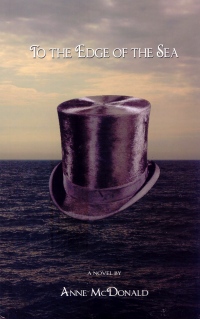| ________________
CM . . .
. Volume XIX Number 26. . . .March 8, 2013
excerpt:
Promotional material from Thistledown Press says that To the Edge of the Sea will "provide an enriching resource for senior classes, Grades 11 and 12, discussing the political formation of Canada", because it "presents a picture of the social structure of society at that time." Actually, the political issues, events and social structure of 1864 are not in the foreground of McDonald's novel. To the Edge of the Sea is not a historical novel, like Gore Vidal's Lincoln, in which the characters move through great events and discuss them. Rather, it is an impressionistic work like Jane Urquhart's Away, taking readers into the main characters' psyches. Readers in their mid to late teens may well be fascinated by a look into the souls of four main characters, three of them young people who want "more" in the sense of a wider sphere in which to develop and use their talents. Only one of the four main characters gets "more" in a permanent way. Two other themes may also attract young adult readers: the conflict between young dreams and family expectations, and the yearning for romantic/erotic love. The novel begins in Charlottetown, Prince Edward Island, in the summer of 1864, where a conference is taking place to discuss the union of the British North American provinces. At the same time, a circus is in town, the first in P.E.I. in twenty years. The American Civil War is keeping the circus away from the U.S. Eastern Seaboard ports, and so it is visiting British North American ports instead and will eventually head up the St. Lawrence River to Niagara Falls. Alex, a fisherman's son, has taken off to see the circus without paternal permission. Though he regrets not including his brother, Reggie, in this adventure, he is entranced by the performances of two trapeze artist brothers. John A. Macdonald, the driving force in favour of Confederation, finds it unusual and exhilarating to be on an island: "The cold of the water on his sun-warmed skin made him shiver, raised bumps of flesh and his skin tingled, tightened with salt." George Coles, who has served many terms as P.E.I. Premier, is among those welcoming the Canadian delegation, and his 26-year-old daughter, Mercy Ann, attends the conference's social events. When 49-year-old Macdonald, a widower, asks her to dance, she feels an instant attraction that she thinks he feels too. Later, when the delegates move on to the Quebec Conference, Mercy goes with her parents to see the sights of Canada East and Canada West. She continues to feel drawn to John A. At one point, he reflects, to himself, that he would like to stop his work, fall in love, and live "on the edge of her island." Anne McDonald has an impressionistic, lyrical style, with several sustained metaphors running through the novel. The circus trapeze is one. First and foremost, it shows the tension between home and freedom. It captures Alex's yearning for thrilling experiences and, at the same time, for his brother - "someone to catch him". The breathtaking back-and-forth of the trapeze also relates to the feelings between Mercy and John A. Water imagery flows through the novel, too. Recalling her childhood swimming lessons with her father, Mercy remembers how, after a lesson, he would go out into the sea, leaving her behind, and disappear beneath the waves. This fear of paternal abandonment may explain her attraction to a powerful man almost twice her age. Meanwhile, Alex joins the circus and travels to Niagara Falls where he is intrigued by the skill and daring of a tightrope walker above the rushing water. Back in Prince Edward Island, his brother Reggie leaves the fishing life, which he never fit into, for a life with farming relatives. Involved in a protest against P.E.I.'s absentee landlords, he feels overwhelmed by the wave of men, as if he were drowning. Later, Reggie meets with mishap trying to save a fish out of water. John A.'s attraction to Mercy peters out because of his preoccupation with his big project, Confederation, and possibly also because of his age and love of alcohol. In Cobourg, Canada West, looking at the night sky, he points out to Mercy a brilliant star that "may have already extinguished its flame." Looking at the burned-out star, Mercy replies that "we deceive ourselves, knowingly believing in something that may not be real." The attraction between Canada's first Prime Minister and George Coles's daughter may not have been real, but rather the invention of Anne McDonald. McDonald, who read Mercy Coles's unpublished diaries, writes: "Although I have used real people and events in this book, I have freely fictionalized intents and events, dates and situations, and all should be read as fiction." In real life, in 1867, John A. married Agnes Bernard, whom he first met in the 1850s through her brother, his principal secretary. But truth in the factual, courtroom sense is not what one should look for in this type of novel. To the Edge of the Sea does not aspire to teach history, but to provide readers with a "sentimental education." Recommended. Ruth Latta's young adult historical novel, The Songcatcher and Me (Ottawa, Baico, 2013) has only made-up characters, no historical figures.
To comment
on this title or this review, send mail to cm@umanitoba.ca.
Copyright © the Manitoba Library Association. Reproduction for personal
use is permitted only if this copyright notice is maintained. Any
other reproduction is prohibited without permission.
NEXT REVIEW |
TABLE OF CONTENTS FOR THIS ISSUE
- March 8, 2013
AUTHORS |
TITLES |
MEDIA REVIEWS |
PROFILES |
BACK ISSUES |
SEARCH |
CMARCHIVE |
HOME |
